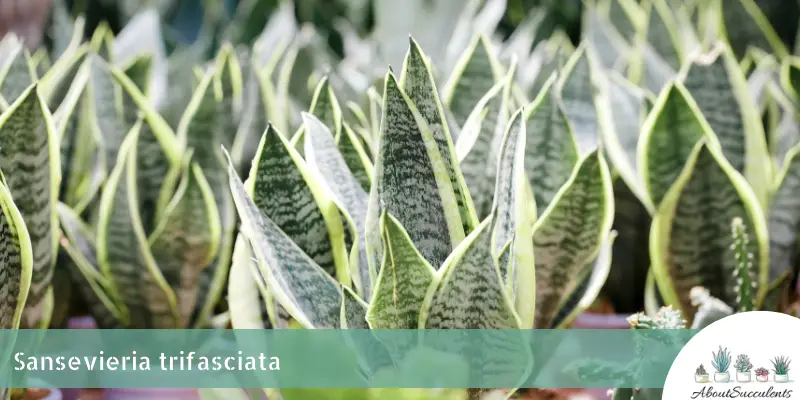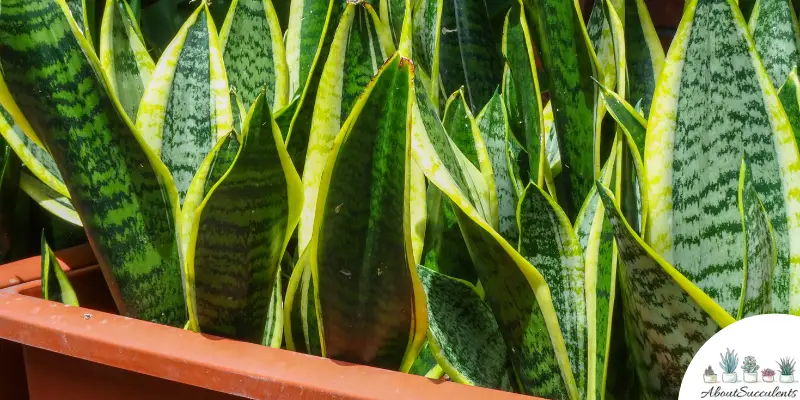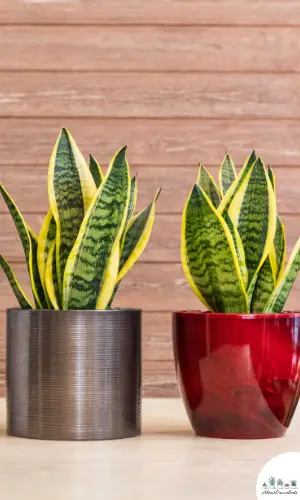
Sansevieria trifasciata is an exotic-looking succulent that you’ve probably seen in many homes. Its stiff banded leaves with a yellow border that can reach a height of 8-feet or 243cm give it the alias Snake Plant. A more humorous nickname for Sansevieria trifasciata is Mother-in-law’s tongue.
Snake Plant is one of the most durable succulent plants you can ever grow. It is cold-hardy and can thrive under a variety of conditions.
If you keep Sansevieria trifasciata as an indoor plant and there are no places with enough sunlight, you have nothing to worry about as this succulent will grow even in the darkest corners of your home.
Perhaps the number one reason why so many succulent growers love Snake Plant is for its health benefits.
Sansevieria trifasciata was used by NASA in 1989 as part of its study on how plants can be used to purify the air and help improve health. A study conducted by Yonsei University and the University of Georgia revealed that Snake Plant has the ability to remove benzene and formaldehyde from the air.
Sansevieria trifasciata is native to Tropical West Africa and is a member of the Asparagaceae family. A fully-grown Snake Plant can reach a height of 12-feet (365cm).
General Information:
Also known as: Snake Plant, Mother-in-Law’s Tongue
Plant Family: Asparagaceae
Origin: Tropical West Africa.
Height: 365cm (12’)
Exposure: Partial or indirect morning sun for up to 6 hours
Water Needs: Drought-tolerant; give water only when the soil has completely dried out.
Soil Type: Cactus mix with gravel, sand or pumice.
Soil pH: 4.5 to 8.5
How to Grow and Care for Sansevieria Trifasciata

If you’re thinking of getting into growing succulent plants as a hobby, Snake Plant is a wonderful variety to start out with because it’s easy to grow and care for.
Sansevieria trifasciata can be grown as an outdoor succulent but many people prefer it as a houseplant.
Whether as an outdoor or indoor succulent plant, Snake Plant will give you several years of enjoyment as a horticulturist or leisure-hobbyist.
Sunlight
If you want to plant Sansevieria trifasciata as an outdoor succulent, place it in an area that gets indirect sunlight for up to 6 hours. Don’t put Snake Plant at a location that receives direct afternoon sunlight.
As an indoor succulent plant, you can place Sansevieria trifasciata in your room to purify the air. The ideal location would be near a window that receives partial sunlight for 3 to 6 hours per day.
Watering

With Sansevieria trifasciata, it is better to give it less water than to overwater the succulent. This is a drought-tolerant plant and will survive a month without water.
Before giving Snake Plant, always check the moisture level of the soil. You can feel the topsoil for moisture but to be sure, insert a stick an inch into the soil. If the end of the stick feels dry, you can water the soil.
The frequency of watering will be less in the wintertime because the soil will remain moist longer.
Potting and Soil
Sansevieria trifasciata is a sturdy variety of succulent plant and will hardly need repotting.
If you bought Snake Plant from a garden store and it’s housed in a plastic container, re-pot in a container that’s made of ceramic or terracotta for better evaporation of moisture from the soil.
Sansevieria trifasciata also has large and long roots. Make sure the pot is big enough to allow the roots to stretch out and grow without getting tangled with each other.
Snake Plant will thrive in a standard soil mix or a cactus potting mix. Choose a brand without peat because this ingredient will keep the soil moist longer. Add ingredients that will improve soil drainages such as sand, gravel, pumice, and perlite.
You can fertilize Snake Plant using a 10/10/10 product once a month during Spring but never in the winter.
How to Propagate Sansevieria Trifasciata
Another wonderful reason to grow Sansevieria trifasciata is that it’s easy to propagate. There are 3 methods you can use to multiply Snake Plant: Leaf Cuttings, Water Propagation, and Divisions.
Method 1 – Leaf Cuttings Method
Step 1: Choose a healthy leaf from the main plant.
Step 2: Remove the leaf from the stem by doing a clean twist and pull or by using a sanitized and sharpened pair of garden shears or a knife.
Step 3: Place the leaf cuttings in a dry and warm area. Give them 2 to 3 days to develop hard calluses.
Step 4: Place the callused leaf cuttings on a standard soil mix or cactus mix.
Step 5: Lightly mist the soil whenever it has dried out completely.
Method 2 – Water Propagation Method
Step 1: Remove a healthy leaf from the stem of the main plant with a pair of sterilized and sharpened garden shears or a knife.
Step 2: Place the leaf inside a tall container.
Step 3: Fill the container with enough water to cover the leaf.
Step 4: Position the container in an area that receives indirect sunlight for up to 6 hours.
Step 5: Replace the water every few days.
Method 3 – Divisions Method
Step 1: Snake Plant grows from a large root-like organ called a rhizome. You can find the rhizome under the soil and you will notice the leaves growing from it.
Step 2: Divide the rhizome by cutting it with a sterilized and sharpened knife. Make sure the divided part of the rhizome has a leaf growing out of it.
Step 3: Allow the divided sections of the rhizome to dry for one day.
Step 4: Plant the divisions in cactus or standard soil mix and provide water when the soil is very dry.
Frequently Asked Questions
Is Sansevieria Trifasciata Toxic to Cats and Dogs?
Sansevieria trifasciata does not appear on the list of plants that are toxic to cats and dogs on the website of the American Society for the Prevention of Cruelty to Animals (ASPCA) but there are other reports that state Snake Plant is toxic to pets.
Don’t take chances and keep pets away from chewing on Snake Plant. If ingested, bring your pet to the veterinarian immediately.
Why Is My Sansevieria Trifasciata Dying?
If your Sansevieria trifasciata is dying, there could be 2 possible reasons: Overwatering and pest infestation.
Overwatering
Keeping the roots in moist conditions for a long time will cause them to rot and develop a fungal infection. A sign of infection is discoloration on the leaves or stem of the Snake Plant.
To save Sansevieria trifasciata, cut off the infected parts with a sanitized and sharpened pair of garden scissors. Uproot the plant from the soil and cut off the rotting roots.
Allow Snake Plant to dry and replace the soil with a fresh batch of cactus mix. Replant the succulent in its new home and water only when the soil is 100% dry.
Pest Infestation
Sansevieria trifasciata is also the favorite succulent of pests such as mealybugs and spider mites. These pests will drain the Snake Plant of its nutritious sap and leave it vulnerable to fungal infection.
If you see white cotton-like substances on its leaves, remove them with 70% isopropyl alcohol or insecticide soap. You can also spray Snake Plant with neem oil to keep pests away.
Does Sansevieria Trifasciata Produce Flowers?
Sansevieria trifasciata hardly blooms flowers but if well-taken care of and mildly stressed with sunlight, it may reward you with white-colored flowers along its stalk that resemble lilies when fully opened.
Last Updated on June 9, 2022 by Sofia Lara